

Japanese Internment Camps in World War 2
Japanese Internment Camps in World War 2
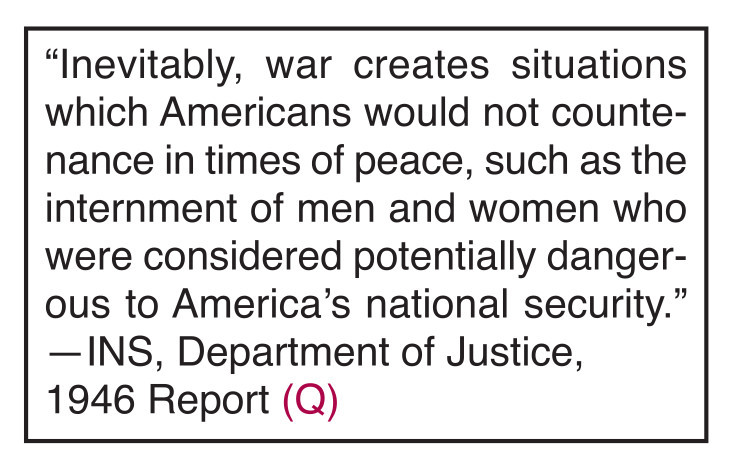
The internment of about 110,000 Japanese Americans during World War Two has been a blight on America’s history since shortly after the war ended. The information in this article is not intended to justify FDR’s Relocation Order issued two and half months after Pearl Harbor. Rather, it gives us greater understanding why the Order was issued. Here is the WHOLE story on the internment of Japanese Americans during World War Two.
Japan’s sneak attack on Pearl Harbor on Dec 7, 1941, was the first direct attack on the US by a foreign power since the war off 1812. Neither Germany or Italy attempted a direct attack on the US.
On Dec. 8, 1941, the United States declared war on Japan. This prompted Germany and Italy to declare war on the United States on Dec. 11, 1941. The U.S. declared war on Germany and Italy later the same day.
In Europe, Nazi Germany defeated Denmark, Norway and destroyed the Armies of France, Belgium and The Netherlands in only 6 weeks. Only Britain was left. Germany seemed invincible.
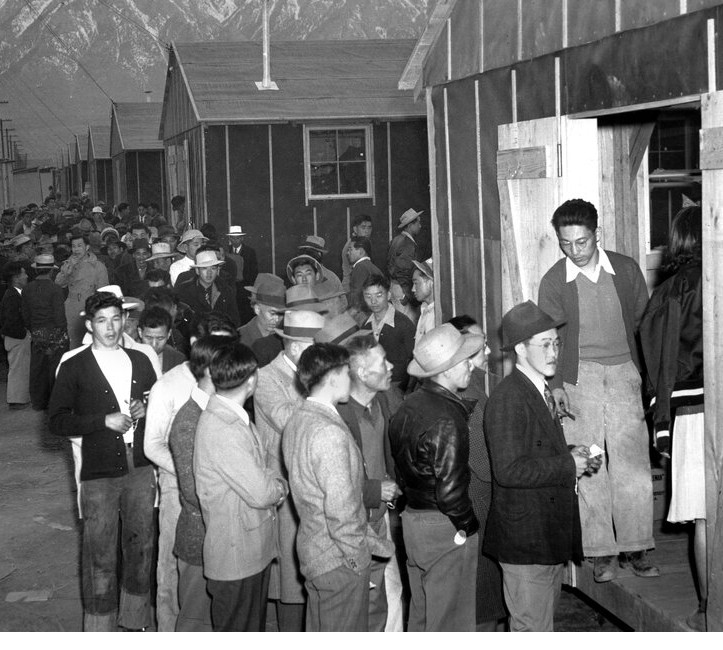
In April, 1941, Japan signed a non aggression treaty with the Soviet Union, allowing Japan to concentrate most of it’s military power against the U.S. The attack on Pearl Harbor killed over 2,400 personnel, wounded 1,300, sank 4 battleships and destroyed 188 aircraft. Japan had already conquered large parts of Asia and attacked the Philippines on Dec. 8, 1941, where 16,000 U.S. soldiers were cut off and doomed to die – or worse – be taken prisoner by the sadistic Japanese Army.(A) The Japanese military seemed invincible.
The attack on Pearl Harbor resulted in a bizarre incident on the Hawaiian Island of Niihau. A damaged Japanese fighter plane crash landed on the island. Of the 136 people on the island, three were of Japanese descent and the Japanese pilot got all three to side with him and attempted to conquer the island for Japan. During the confrontation, the Japanese pilot was killed and one of the ethnic Japanese committed suicide.(B)
After the ordeal, the Hawaiians were troubled by “the rapidity with which the three resident Japanese went over to the pilot’s cause. The more pessimistic among them cited the Niihau incident as proof that no one could trust any Japanese, even if an American citizen, not to go over to Japan if it appeared expedient.”[C]
In the official Navy report on the Niihau incident, dated January 26, 1942, its author, Navy Lieutenant C. B. Baldwin, wrote, “The fact that the two Niihau Japanese who had previously shown no anti-American tendencies went to the aid of the pilot when Japanese domination of the island seemed possible, indicate[s] [the] likelihood that Japanese residents previously believed loyal to the United States may aid Japan if further Japanese attacks appear successful.”(D)

similar to U.S. Army troop barracks.
Following the bombing of Pearl Harbor, Roosevelt issued three presidential proclamations to remove non-citizens: #2525 (Japanese), #2526 (Germans), and #2527 (Italians).
The U.S. Government interned approximately 11,000 ethnic Germans – nearly all non-citizens and 1,880 ethnic Italians. On October 12, 1942, restrictions were lifted for all Italian non-citizens who were long-term residents of the U.S. After Italy surrendered to the Allies on September 8, 1943, most Italian nationals were released by the end of the year.
In late 1940. U.S. intelligence broke the Japanese code. Intercepts indicated the possible existence of a Japanese spy ring on the west coast of the U.S.(E) Because all three ethnic Japanese on Niihau sided with Japan, many assumed there had to be some spies within the Japanese living on the West coast.
The Niihau incident, combined with the intercepts (F) had a profound effect on FDR, who issued Executive Order 9066 in February 19, 1942. This Order allowed local military commanders to designate “military areas” as “exclusion zones”, from which “any or all persons may be excluded.”
Ironically, just four days later, at sunset on Feb 23, a Japanese sub shelled an oil refinery near Santa Barbara, California causing light damage. Some witnesses claimed seeing “signal lights” from the sub – apparently to spies on shore. (G) The only real accomplishment of this sub attack was to give further justification to FDR’s relocation order.
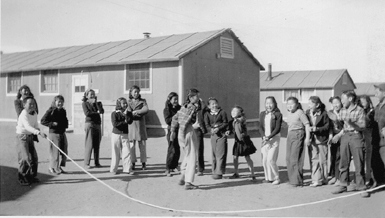
The sub attack convinced some in Japan’s leadership that it was possible to attack the U.S. mainland. The Tokyo newspaper Kokumin said the attack showed that “occupation of the United States mainland no longer is in the realm of dreams.” (G) World War Two was a fight to the death. Had the Japanese won the battle of Midway, Hawaii would have been next and then the west coast of the U.S.
In 1941, the census showed 127,000 Japanese in the US – most in California.(H) Removal of 110,000 Japanese Americans from the west coast eliminated the possibility of local Japanese Americans helping Japan in the event of an invasion, or more likely, Japanese subs landing sabotage teams along the West Coast. Approximately 5,000 voluntarily moved out of the West coast exclusion zone before the March 1942 deadline.(I)
In June, 1942, Nazi subs landed sabotage teams in Florida and New York. All 8 men were quickly captured with six being executed. (J)
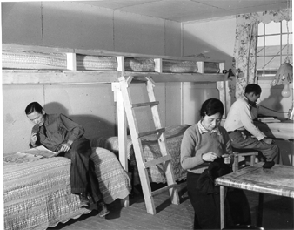
at the Granada Camp, Colorado.(R)
Prior to Pearl Harbor, a Nazi spy ring – dubbed the Duquesne Spy Ring.(K) was operating in the eastern U.S. A naturalized American, William Sebold, was born in Germany and became of U.S. citizen in 1936. When he visited his ailing mother in Germany in February, 1939, he was recruited by the Nazis to spy on the U.S. When he got back to the U.S. he informed the FBI of the scheme and exposed the traitors. On June 28, 1941, all 33 spies were arrested. The FBI informed President Roosevelt they were certain that there were no more German spy rings in the U.S. The FBI could not say the same about possible Japanese spy rings on the west coast.
While the internment of the Japanese Americans was somewhat controversial, it was mostly ignored as the country united in an all out effort to defeat Japan, Italy and Germany. After the war, many felt the country had over reacted, but in 1942, the Allies were losing the war and Americans were not taking any chances.
Many people blame racism for the internment – and racism was certainly a factor. But there were legitimate reasons to be suspicious. We can only speculate if FDR’s Relocation Order would have been issued had the three islanders of Japanese descent on Niihau fought the Japanese pilot instead of siding with him.
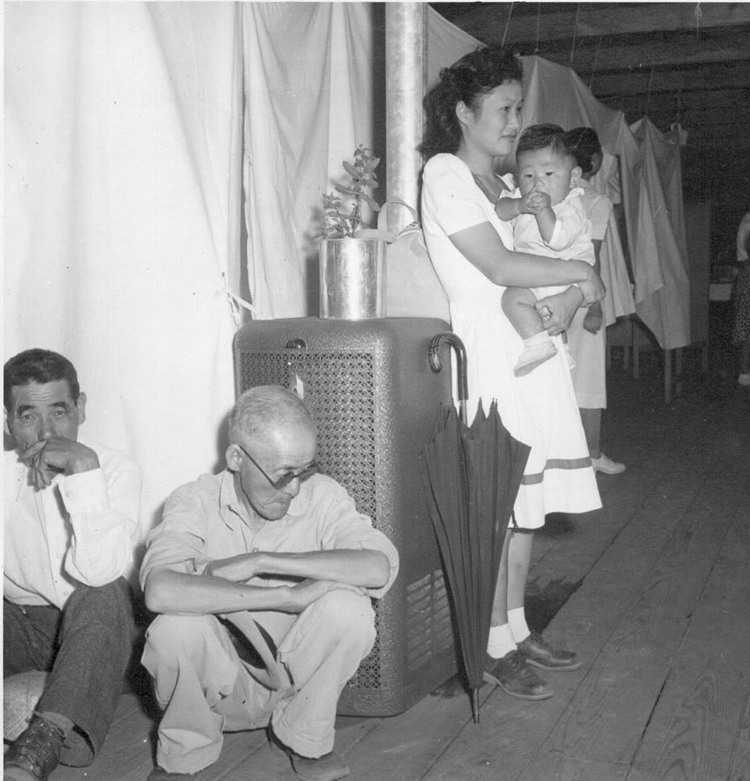
In the fall of 1943. Another incident that shook Americans occurred. Three Japanese American women interned at Granada Camp in eastern Colorado, helped two German prisoners of war escape from their nearby POW camp. They gave the prisoners civilian clothing, some maps, and a nighttime lift south toward Mexico.(L)
Critics note that no Japanese Americans was charged with espionage. Since nearly all Japanese were in internment camps, this is an empty boast.
Despite the tribulations of Japanese Americans, about 10,000 volunteered for military duty in Europe. Known as the 442nd Infantry Regiment, the unit received over 4,000 Purple Hearts, seven Presidential Unit Citations and twenty-one men were awarded the Medal of Honor in under two years. They were the most decorated unit in World War Two.
Over the next two years, nearly a quarter of the internees left the camps to live and work elsewhere in the United States, outside the exclusion zone. Eventually, some were authorized to return to their hometowns in the exclusion zone under supervision of a sponsoring American family or agency whose loyalty had been assured. Japanese of college age were permitted to leave the camps to attend nearby institutions willing to accept students of Japanese ancestry. From all 10 camps, 4,300 people attended college. (M)
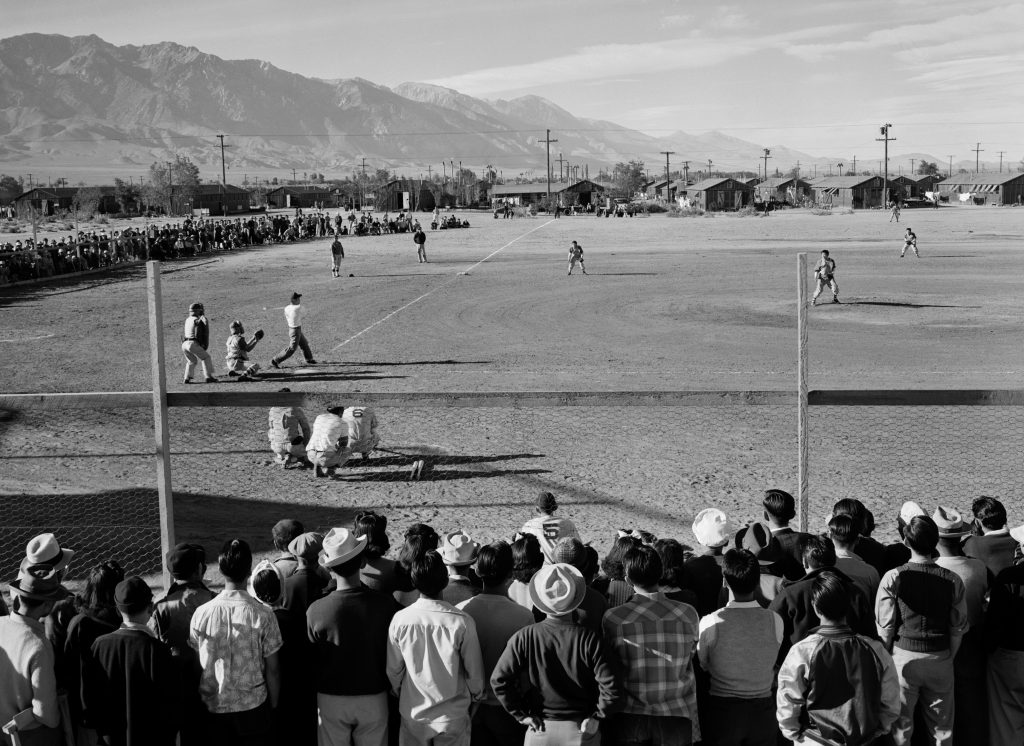
Critics have attacked the housing accommodations of the internees. The fact is millions of American servicemen lived in the same type of wooden barracks and had to share toilets, bathing and dining facilities. Although these accommodations were acceptable for young men in the military, in a family setting, this was pretty spartan. Each Internment camp included schools, post offices and work facilities, as well as farmland for growing food and keeping livestock. Each prison camp was completely surrounded by barbed wire and guard towers.
An Issei doctor was appointed to manage each facility. At Manzanar, hospital staff performed over 40,000 immunizations against typhoid and smallpox. Professionals were paid $19 per month, skilled workers received $16 and nonskilled workers got $12.(M)
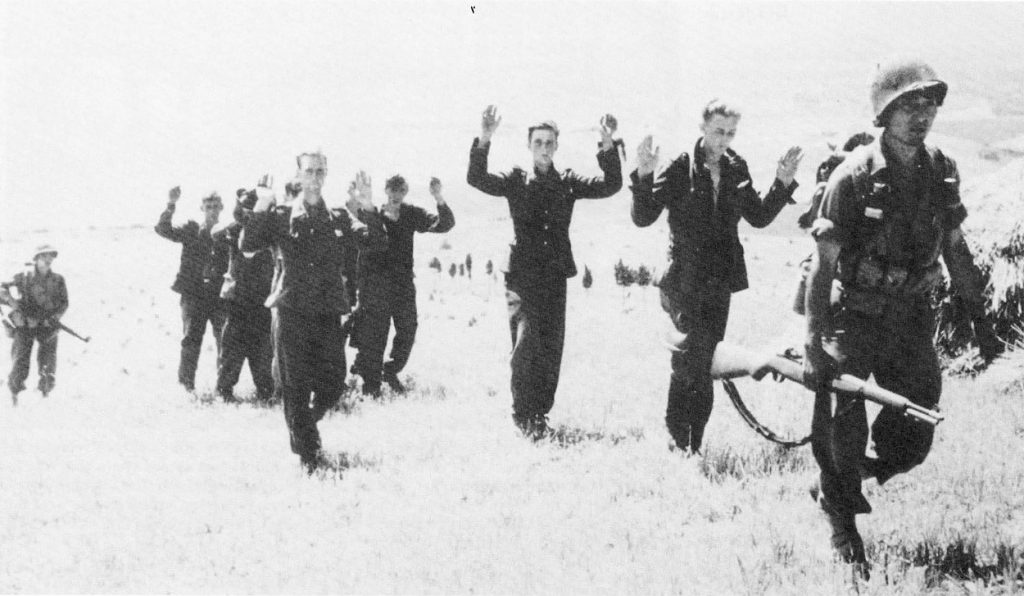
Regiment in Italy in 1944. (W)
On Dec. 17, 1944, with Japan’s defeat in sight, U.S. General Henry Pratt issued Public Proclamation No. 21, declaring that Japanese American “evacuees” from the West Coast could return to their homes, effective January 2, 1945.(N) The problem was that some had no home to go back to.
Some historians have compared the internment of Japanese Americans to the persecutions of other ethnic minorities in the World War II era but this is a fraudulent comparison. An estimated 500,000 Volga Germans were rounded up and deported to Siberia and Kazakhstan by Stalin with many of them dying en route.(O) In 1944, the Red Army rounded up about 500,000 Chechens and Ingushes for relocation. A third of them died.(P)
A big controversy has been what to call these camps – Internment/Relocation camps or Concentration camps. Concentration camps were places of torture, barbarous medical experiments and extermination centers. The camps for the Japanese did none of this. The Japanese were in Internment/Relocation camps.
Below are three pictures from Nazi Concentration Camps.

Below are three pictures from Japanese Concentration Camps.
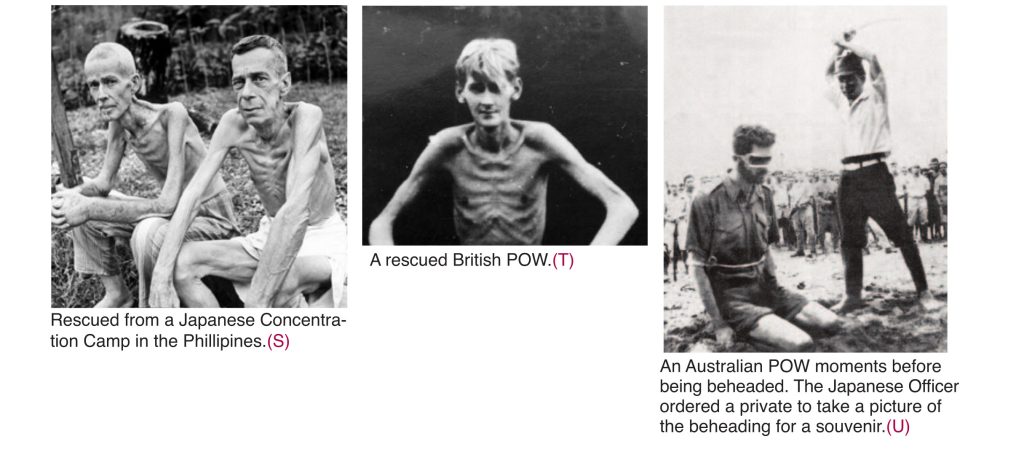
Of the 27,000 Americans taken prisoner by the Japanese, a shocking 40 percent died in captivity, according to the U.S. Congressional Research Service. That compares with just one percent of American prisoners who died in German POW camps. (V)
In 1988, President Ronald Reagan signed the Civil Liberties Act, formally apologizing on behalf of the US government and granting $20,000 to each surviving detainee. The act claimed that “racial prejudice, wartime hysteria and a lack of political leadership” led to the forced removal of people of Japanese ancestry.
Source:
A. Unbroken: A World War II Story of Survival, Resilience, and Redemption. by Laura Hillenbrand, pub 2014 Random House
B. http://internmentarchives.com/showdoc.php?docid=00211&search_id=49022&pagenum=47 p 474,475.
C. December 7, 1941: The Day the Japanese Attacked Pearl Harbor by Prange, Gordon W. McGraw Hill. p 375-377
D. Beekman, Allan (1998) [1982]. The Niihau Incident. Honolulu, HI: Heritage Press of Pacific. ISBN 0-9609132-0-3. p 112
E. https://internmentarchives.com/showdoc.php?docid=00211&search_id=49022&pagenum=4 (Page 431)
F. Magic: The Untold Story of U.S. Intelligence and the Evacuation of Japanese Residents, pub 2000 by David D. Lowman
G. http://articles.latimes.com/1992-03-01/local/me-5256_1_japanese-submarine
H. https://www2.census.gov/library/publications/decennial/1940/population-nonwhite/population-nonwhite.pdf
I. https://encyclopedia.densho.org/Voluntary_evacuation/
J. http://www.historynet.com/world-war-ii-german-saboteurs-invade-america-in-1942.htm
K. https://www.fbi.gov/history/famous-cases/duquesne-spy-ring
L. https://encyclopedia.densho.org/Prosecution_of_the_Shitara_Sisters/
M. https://www.nps.gov/manz/learn/historyculture/japanese-americans-at-manzanar.htm
N. https://www.history.com/this-day-in-history/u-s-approves-end-to-internment-of-japanese-americans
O. Open Wound: The Genocide of German Ethnic Minorities in Russia and the Soviet Union: 1915-1949 and Beyond by Samuel Sinner. Between 1915 and 1949, Russian and later Soviet troops exterminated literally the entire ethnic German population living in Russia, many for centuries. This genocide encompassed 34 years under three different rulers; Tsar Nicholas II, Lenin, and Stalin. Stalin’s forced dispersal of virtually the entire German population of the USSR to special settlements and labor army work sites during the 1940s brought the total death toll of ethnic Germans due to the policies of the Russian and Soviet governments to around one million.
P. Mohit Kumar Ray, Rama Kundu, Pradip Kumar Dey (2005). “Widening horizons: essays in honour of Professor Mohit K.
Ray”. Sarup & Sons. p.150.
Q. http://www.thc.texas.gov/public/upload/publications/Final-Crystal%20City%20broch.pdf
R. https://web.archive.org/web/20081004043059/http://www.colorado.gov/dpa/doit/archives/wwcod/granada5.htm
S. https://c1.staticflickr.com/5/4135/4899368740_10e558a392_z.jpg
T. https://www.mirror.co.uk/news/world-news/harrowing-photos-reveal-starving-war-11164629
U. http://histclo.com/essay/war/ww2/pow/pow-jap.html
V. https://time.com/3334677/pow-world-war-two-usa-japan/
W. https://scalar.usc.edu/works/csujad-exhibit/go-for-broke
Oct 2022
You may be interested
Slavery and the Founding Fathers
Slavery was NOT an American invention. Virtually every civilizations since...
Manifest Destiny
The term "Manifest Destiny" is usually associated with the territorial...
Mexico’s secret War against the U.S.
1) Mexican claims of land theft by the U.S. are...
Leave a Reply